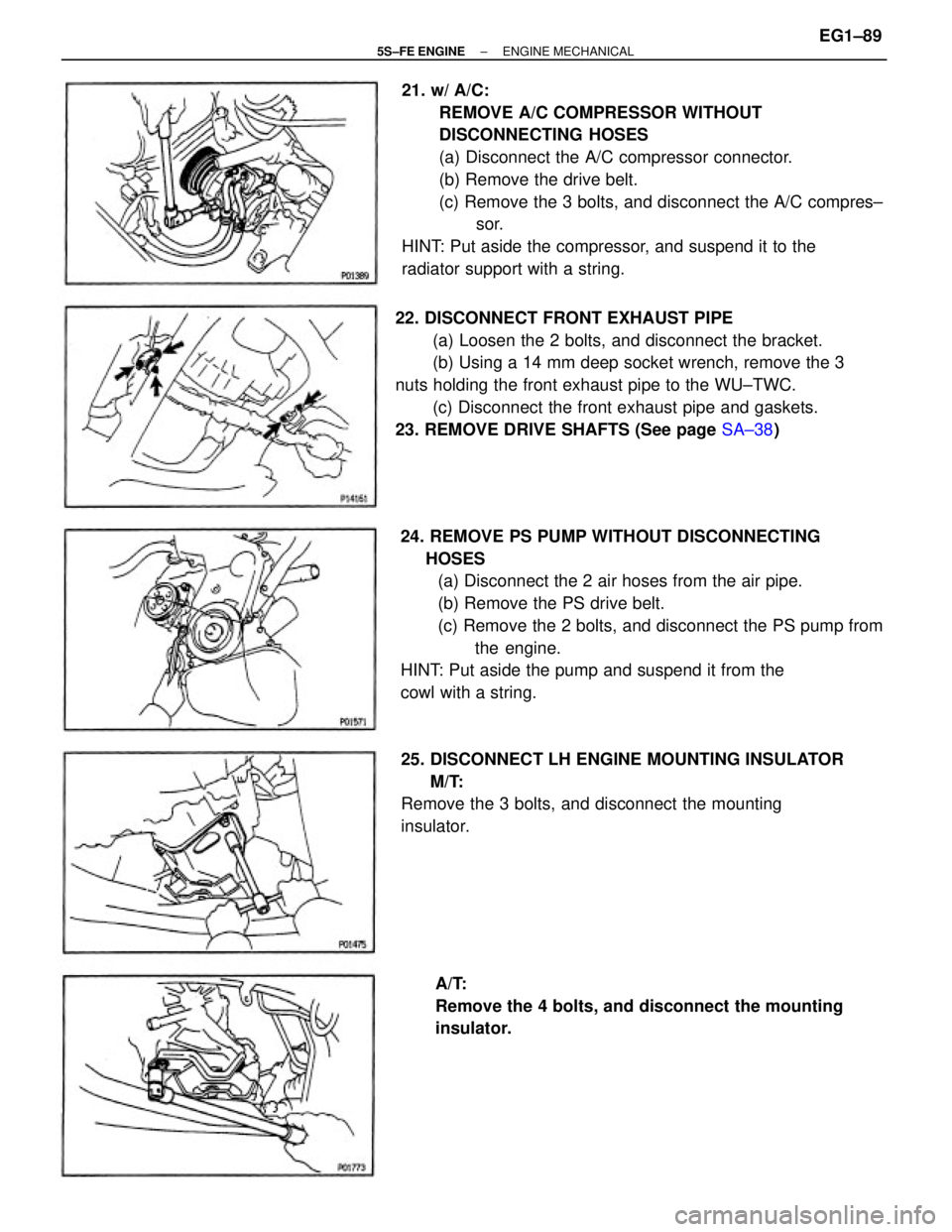Page 139 of 4770

21. w/ A/C:
REMOVE A/C COMPRESSOR WITHOUT
DISCONNECTING HOSES
(a) Disconnect the A/C compressor connector.
(b) Remove the drive belt.
(c) Remove the 3 bolts, and disconnect the A/C compres±
sor.
HINT: Put aside the compressor, and suspend it to the
radiator support with a string.
24. REMOVE PS PUMP WITHOUT DISCONNECTING
HOSES
(a) Disconnect the 2 air hoses from the air pipe.
(b) Remove the PS drive belt.
(c) Remove the 2 bolts, and disconnect the PS pump from
the engine.
HINT: Put aside the pump and suspend it from the
cowl with a string. 22. DISCONNECT FRONT EXHAUST PIPE
(a) Loosen the 2 bolts, and disconnect the bracket.
(b) Using a 14 mm deep socket wrench, remove the 3
nuts holding the front exhaust pipe to the WU±TWC.
(c) Disconnect the front exhaust pipe and gaskets.
23. REMOVE DRIVE SHAFTS (See page SA±38)
25. DISCONNECT LH ENGINE MOUNTING INSULATOR
M/T:
Remove the 3 bolts, and disconnect the mounting
insulator.
A/T:
Remove the 4 bolts, and disconnect the mounting
insulator.
± 5S±FE ENGINEENGINE MECHANICALEG1±89
Page 302 of 4770
2. DRAIN ENGINE COOLANT (See page EG1±241)
3. w/ CRUISE CONTROL SYSTEM:
REMOVE CRUISE CONTROL ACTUATOR COVER
4. DISCONNECT ENGINE COOLANT TEMPERATURE
SWITCH CONNECTOR FROM FAN SHROUD
5. DISCONNECT ELECTRIC COOLING FAN
CONNECTORS
9. REMOVE RADIATOR AND ELECTRIC COOLING
FANS
(a) Remove the 2 bolts and 2 upper supports.
(b) Lift out the radiator.
(c) Remove the 2 lower radiator supports. 6. DISCONNECT RADIATOR HOSES
(a) Disconnect the upper hose from the radiator side.
(b) Disconnect the lower from the water inlet pipe.
7. DISCONNECT ENGINE COOLANT RESERVOIR
HOSE
10. REMOVE RADIATOR LOWER HOSE
11. A/T:
REMOVE A/T OIL COOLER HOSES 8. A/T:
DISCONNECT OIL COOLER HOSES
± 5S±FE ENGINECOOLING SYSTEMEG1±252
Page 309 of 4770
(b) Place the radiator in position, and install the 2 upper
supports with the 2 bolts.
HINT: After installation, check that the rubber cushion
(A) of the support is not depressed.
Torque: 13 N±m (130 kgf±cm, 9 ft±lbf)
6. INSTALL RADIATOR AND ELECTRIC COOLING
FANS
(a) Place the 2 lower radiator supports in position on the
body. 4. A/T:
INSTALL A/T OIL COOLER HOSES
5. INSTALL RADIATOR LOWER HOSE
8. CONNECT ENGINE COOLANT RESERVOIR HOSE
9. CONNECT RADIATOR HOSES 7. A/T:
CONNECT OIL COOLER HOSES
± 5S±FE ENGINECOOLING SYSTEMEG1±259
Page 317 of 4770
SERVICE SPECIFICATIONS
SERVICE DATA
TORQUE SPECIFICATIONS
Valve opening temperature
Valve lift
Water bypass pipe x Water pump cover
Radiator oil cooler x Radiator lower tank Water pump x Water pump cover
No.2 idler pulley x Cylinder block Water inlet x Water pump coverRelief valve opening pressure
Water pump x Cylinder blockCylinder block x Drain plug
Water inlet x Water pump
Radiator oil cooler pipe
Radiator support boltElectric
cooling fanRotating amperage
Part tightened Radiator cap
Plate height Thermostat
Radiator
± 5S±FE ENGINECOOLING SYSTEMEG1±267
Page 511 of 4770

32ENGINEÐ5S±FE ENGINE
� MAJOR DIFFERENCES
Major differences between the new 5S±FE engine and previous engine are listed below.
Item
Features
Engine ProperThe squish area of the combustion chamber in the cylinder head has been
optimised to improve torque in the low±to mid±speed range.
Cooling SystemAn aluminum radiator core is used for weight reduction.
Intake and Exhaust System
�The ports of the manifold have been extended to improve torque in the low±
to mid±speed range.
�The exhaust manifold is made of stainless steel plates for improve engine per-
formance and weight reduction.
�Through the optimized allocation of the exhaust pipe supports, the number of
supports has been reduced from 5 to 4, thus reducing the noise and vibration
which are transmitted to the vehicle body.
Fuel SystemA fuel returnless system has been adopted to prevent the internal temperature
of the fuel tank from rising and to reduce evaporative emissions.
Ignition SystemThe DIS (Direct Ignition System) contributes to the powerful high output by
providing a powerful spark to the engine.
Engine MountingTo reduce noise and vibration and to improve drivability, the allocation of the
engine mounts*1 and their characteristics have been revised.
Engine Control System
�The injection pattern for engine starting have changed form the 2 group
injection type to sequential multiport injection type.
�In place of the oxygen sensor (bank 1, sensor 1), a new air fuel ratio sensor has
been adopted. *
2
�The power steering idle±up control has been changed from the system using
an air control valve to the one using a pressure switch and an IAC valve.
Emission Control System
�The EGR valve body has been changed from cast iron to aluminum alloy for
weight reduction.
�A TWC (Three±Way Catalytic Converter) that is integrated with a stainless
steel exhaust manifold has been adopted.*
2
�The TWC, which was previously installed below the exhaust manifold has
been discontinued.*3
*1: Only for Automatic Transaxle Models.
*
2: Only for California Specification Models.
*
3: Except for California Specification Models.
Page 525 of 4770

46ENGINEÐ1MZ±FE ENGINE
� MAJOR DIFFERNCES
Major differences between the new 1MZ±FE engne and previous engine are listed below.
Item
Outline
Cooling SystemAn aluminum radiator core is used for weight reduction.
Intake and Exhaust System
Through the optimized allocation of the exhaust pipe supports, the number
number of supports has been reduced from 5 to 4, thus reducing the noise
and vibration which are transmitted to the vehicle body.
Fuel SystemA fuel returnless system has been adopted to prevent the internal temperature
of the fuel tank from rising, and to reduce evaporative emissions.
Engine MountingThe characteristics of the engine mounts, torque rod, and absorber have been
optimized to reduce noise and vibration.
Engine Control System
�A communication circuit has been provided between the ECM and the
ABS & TRAC ECU in conjunction with the adoption of the TRAC
(Traction Control) system.*
�The fuel pressure control has been discontinued in conjunction with the
adoption of the fuel returnless system.
�Instead of using the IDL signal input from the throttle position sensor,
the ECM now uses the VTA signal to detect the completely closed state of
the throttle valve.
�A new EGR system which uses a EGR valve position sensor is used.
�A communication method of the ECM and the hand±held tester has been
changed from the SAEJ1962 to the ISO 9141±2.
*: Applicable only to Vehicle Equipped with the TRAC System.
Page 624 of 4770
RADIATOR UPPER SUPPORT (ASSY)
REMOVAL
BODY PANEL REPLACEMENTRE-2
Page 626 of 4770
RADIATOR SIDE SUPPORT (ASSY)
REMOVAL (With the radiator upper support removed.)
Radiator Support to
Front Fender
Bracket.
1. Replace the radiator support to front fender
bracket at the same time.
BODY PANEL REPLACEMENTRE-4